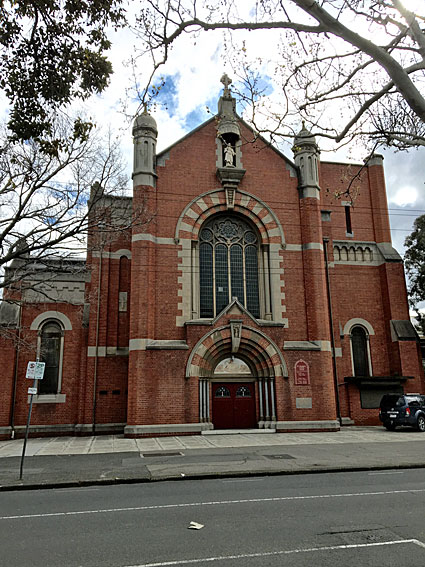
St Brendan's Catholic Church, Flemington
[Photograph by John Maidment (September 2016)]

St Brendan's Catholic Church, Flemington
[Photograph by John Maidment (September 2016)]
Historical and Technical Documentation by Geoffrey Cox and John Maidment
© OHTA 2016, 2017 (last updated September 2017)
The first church in Flemington dedicated to St Brendan was opened on Sunday 4 July 1886. The parish separated from St Monica's Essendon in 1891 with the appointment of Fr. Cornelius Sheahan as the first Parish Priest.1
The present church was opened and blessed by Archbishop Mannix on 6 July 1924. Music was an early priority, and a trained choir was formed to sing at the opening under the direction of Mr. T.A. Dennett, jun. Particular attention was given on this occasion to the use of 'appropriate' music in line with the Motu Proprio of Pius X.2
The building was designed by the prolific Melbourne architect, Augustus Andrew Fritsch (1866-1933),3 who was responsible also for the design of several other Catholic churches in Victoria, including St Mary's, Bairnsdale (1914), Our Lady of Victories, Camberwell (1918), Our Lady of Mount Carmel, Middle Park (1927) and St Columba's, Elwood (1929). Like the Middle Park and Elwood churches, St Brendan's is built in Romanesque revival style using brownish-red brick with white cement, but featuring an asymmetrically placed square tower on the west front.4
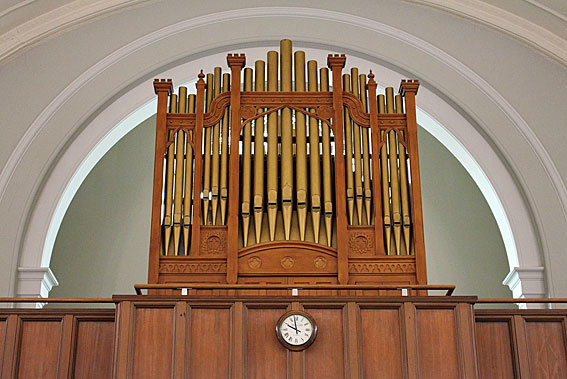
The 1884 Alfred Fuller Organ at Flemington
[Photograph by Trevor Bunning (September 2017)]
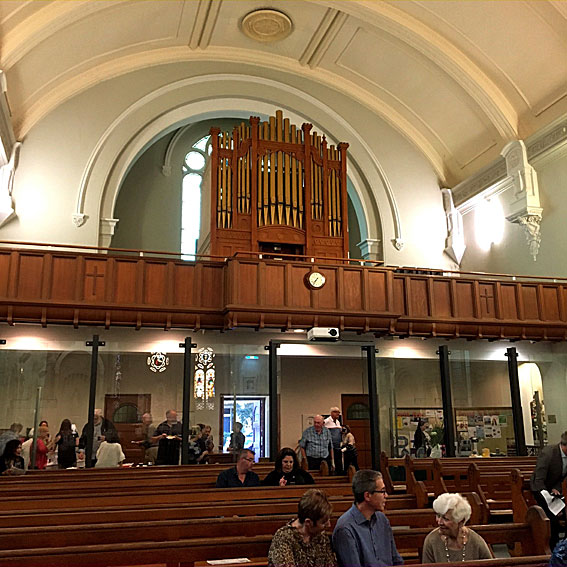
The 1884 Alfred Fuller Organ at Flemington
[Photograph by John Maidment (November 2016)]
The organ now at St Brendan's was built by Alfred Fuller (1845-1923) of Kew. Born in the English county of Essex, Fuller was articled to the London organ builder G.M. Holdich. He emigrated to Australia in 1871, settling in Melbourne, where his first organ was built for the Melbourne International Exhibition of 1880-81.5 The Flemington instrument was built originally for the Independent (Congregational) Church, Kew, where it was opened on Thursday 1 May 1884 with a recital by Mr J.R. Edeson, organist of the Scots' Church, Melbourne. The choir was accompanied on the occasion by Mr W. M'Bean, organist of the Congregational Church, Richmond:
KEW INDEPENDENT CHURCH – OPENING OF NEW ORGAN
On Thursday, 1st May, an interesting event took place at Kew, namely, the inauguration of a new organ, the gift of Mr. Bell. The church being at present without a pastor, the Rev. J. King, who had kindly consented to preside, conducted a brief service. After singing the 100th Psalm, the Rev. T Laver offered prayer, and Mr. King delivered an address on "Music in Relation to the Worship of God," which appears in full in another column. Sir John Goss's anthem "Praise the Lord, O my soul," was then sung by the choir, accompanied on the organ by Mr. M'Bean, of Lennox-street Church, Richmond; after which Mr. J. R. Edeson, organist of Scots' Church, Melbourne, performed an organ selection, consisting of (1) Adagio in A, from a clarionet concerto by Spohr; (2) Prelude and fugue in E Minor, J. S. Bach; and (3) Slow movement in A flat, from a fantasia by Mozart. Mr. W. Thompson, accompanied by Mr. M'Bean, sang "The Priory Gate" with great taste, the familiar hymn tune with which it concludes being immediately recognised by the hearers. Mr. Edeson then gave as organ solos the Adagio, with variations, from a string quartette by Haydn (Op. 75, No. 3), the Dead March from Handel's "Saul" (a tribute of respect to the memory of Sir M. Costa, news of whose decease had lately been received), and the March from Costa's "Eli". . . .
The organ, built by Mr. A Fuller, of Main-road, Kew, is a beautifully finished instrument, with swell and great organ manuals of full compass, CC to G, 56 notes, and radiating concave pedals from CCC to F, 30 notes. There are sixteen speaking stops, viz., on the great organ, open diapason, clarabella, dulciana, principal, harmonic flute, twelfth, flautina, and cremona. On the swell are geigen principal, gedact, keraulophon, gemshorn, harmonic piccolo, and oboe. On the pedal organ are a bourdon of 16 feet tone, and violoncello. The mechanical arrangements are tremulant to swell; three couplers, viz., swell to pedals, swell to great, and great to pedals; and three composition pedals. The bourdon is larger in scale than is commonly found in organs of this size, allowing a full volume of tone to be obtained without sacrificing any other excellence. The whole instrument is rich and sweet, admirably adapted to sustain, without overpowering, congregational singing; yet offering abundant resources to the solo player. The reeds are both particularly good; that on the swell, under Mr. Edeson's able management, excited especial admiration. Mr. Fuller deserves very great credit for producing so good a specimen of his craft, every detail, even to the music desk and stop handles, being worthy of a first-class builder. Mr. Fuller has decorated the case and pipes according to designs specially prepared by Mr. F. J. Smart of Messrs. Reed, Henderson and Smart. The case is in hues of chocolate, with the leading pipes picked out in gold; the pipes, of a ground tint corresponding with the church walls, are adorned in an entirely novel manner, the effect being very rich, without loss of the subdued character appropriate to the surroundings. The whole elicited general approbation. Our friends at Kew are to be congratulated on the acquisition of a valuable aid to their "service of song in the house of the Lord."6
Another account of the opening appeared in The Argus, including the following comment:
The organ, built by Mr. Fuller, of Kew, contains two manuals and a pedal clavier of full compass. The instrument throughout is voiced to produce effects of sweetness and richness rather than brilliancy, and the reeds are of unusual excellence."7

The 1884 Alfred Fuller Organ at Brighton
[Photograph by John Maidment (2006)]
The reference above to the architect, F.J. Smart, may apply only to the decoration of the case and pipes, rather than the case design as a whole. It is significant that the firm of Reed, Henderson and Smart was reported to have designed the case for Fuller's organ at the Baptist Church, Collins Street (1885), in which instance Mr Robert Reid [sic] was said to have been responsible for the "artistic decoration" of the front pipes.8 The case of the Kew organ is also strikingly similar to that of Fuller's organ built for the Wesleyan (now Uniting) Church, Long Gully, Bendigo (1882). The Long Gully Church, opened in 1877, was designed by Messrs Vahland & Getzschmann, but there is no mention of who designed the case when the organ was installed in 1882.9 It appears, nevertheless, that the firm of Reed, Henderson and Smart was responsible for designing at least three of Fuller's cases, and these are distinct from his cases in general.
Fuller's 1884 organ had been removed from the Congregational Church, Kew, by 19 February 1891, when a new three-manual instrument by Alfred Fuller was opened there.10 The cost of the new organ was "reduced by the builder, taking back the old instrument."11
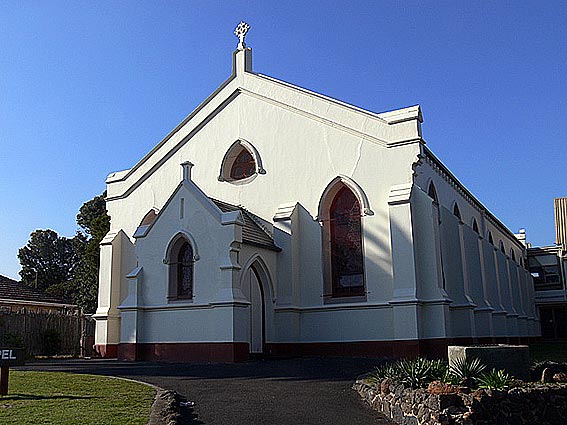
Girrawheen Community Church (formerly Wesleyan Church), Brighton
[Photograph by John Maidment (2006)]
Between 1889 and 1892, George Fincham provided estimates to supply an organ of eleven stops for the Wesleyan Church at Brighton.12 By March 1893, the Brighton church had undertaken alterations to the building, including a new organ chamber, and had installed a 16-stop organ by Alfred Fuller. This was almost certainly the instrument that Fuller had removed around 1891 from the Independent Church, Kew, although the original Violoncello stop on the Pedal had, by this stage, been replaced by an Open Diapason 16ft stop. A description of the organ at the time of installation at Brighton refers specifically to the "grandeur, power and fullness of the full organ [and] to the excellent diapasons":
WESLEYAN CHURCH, BRIGHTON
The Trustees of the New street Wesleyan Church have just completed a very important series of alterations and additions to the church and school buildings. The church has been lengthened and an organ chamber built at the east end, and a new school hall has been added with an entrance from Allee street. . . .
DESCRIPTION OF THE ORGAN.
This beautiful new organ now erected in the Church by Mr Alfred Fuller, of Kew, occupies a commanding position in a handsomely designed recess behind the choir gallery and pulpit, and presents to view an imposing front, artistically decorated in colours and gold to harmonise with the decorations of the church interior; the several groups of speaking pipes being very richly illuminated. It has two manuals each, CC to G, 56 notes, and pedal organ of 30 notes CCC to F, with 20 stops, 3 combination pedals, 1 crescendo pedal and 820 pipes.
GREAT ORGAN
Open Diapason
Claribel
Dulciana
Principal
Harmonic Flute
Twelfth
Flautina
Cremona (reed)
SWELL ORGAN
Open Diapason
Gedact
Keraulophon
Gemshorn
Harmonic Piccolo
Oboe (reed)
Tremulant.
PEDAL ORGAN
Open Diapason
Bourdon
COUPLERS
Swell to Great
Swell to Pedals
Great to Pedals
8 feet
8 feet
8 feet
4 feet
4 feet
3 feet
2 feet
8 feet
8 feet
8 feet
8 feet
4 feet
2 feet
8 feet
16 feet
16 feet
The selection of stops is considered to be the best that can be made for the church services. The builder of the organ invites attention to the grandeur, power and fullness of the full organ, to the excellent diapasons, to the exquisite delicacy of the softer registers, and to the superior quality and effectiveness of the reed stops.
The instrument throughout is provided with pneumatic pallets, rendering the touch light and elastic, with perfect repetition. No effort has been spared to make the instrument as perfect and complete as possible, and the church authorities are to be congratulated on being the possessors of so fine an organ.
The total outlay inclusive of organ and alterations will be about £1300.13
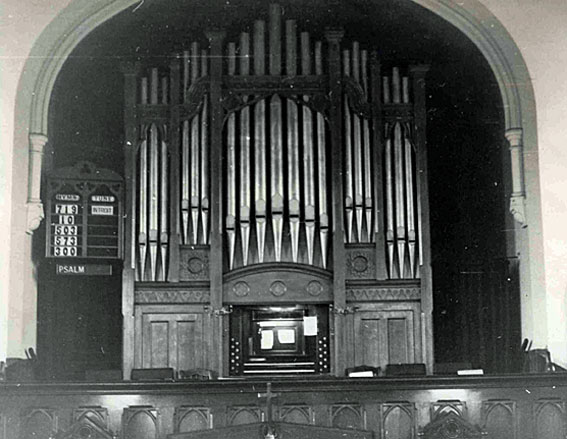
The Fuller organ at Brighton Methodist Church in 1966
[Photograph by John Maidment (1966)]
The organ survived another 95 years in its original state before being rebuilt with electro-pneumatic action in 1968 by Laurie Pipe Organs of Melbourne.14 Laurie replaced the Flautina on the Great with a Fifteenth 2ft, added two stops to the pedals by upward extension, and increased the compass of both the manuals (from 56 to 61 notes) and pedal (from 30 to 32 notes). The original mechanical key and stop action were removed entirely and the wind system was replaced with sprung regulators. The swell shutters were converted to vertical operation.
Although Laurie supplied a new detached stop-key console, the original drawstop console was left intact behind the case doors, which are fitted with cut-crystal knobs. Typical of Fuller in its elaborate construction, the original console features woodwork of French polished mahogany, three rear panels, chamfered edges and a raised music desk, all very similar to Fuller's consoles at the Uniting Church, Long Gully, Bendigo (1882), St John's Lutheran Church, Pella (1885) and St. Brigid's Catholic Church, North Fitzroy (1886). The original tell-tale wind indicator (in this instance on the right-hand side of the organ) is enclosed behind a glass panel, as at Long Gully (1882), St Mark's Catholic Church, Fawkner (1888) and St John's Catholic Church, Heidelberg (1890).
The engraved lettering on the drawstops of the 1884 organ is unusual in that there is a mixture of gothic lettering (for the couplers and tremulant) and square-block lettering (for the remainder), perhaps reflecting a partial replacement when the Pedal Open Diapason was added. The drawstop lettering on Fuller's organs built between between 1885 and 1890 (see above) is entirely gothic (with red initials). Square block lettering, but without the word "FT", can be observed later at Scot's Church, Fremantle, WA (1897) and St Philip's Catholic Church, Blackburn North (1897).
Evidence of the original hitch-down swell lever, which would have connected to horizontal shutters, and of the three composition pedals remains on the old console, and the position of the original hand-blowing lever and brass tell-tale wind indicator, enclosed behind a glass panel, can be seen towards the back of the casework on the right-hand side.
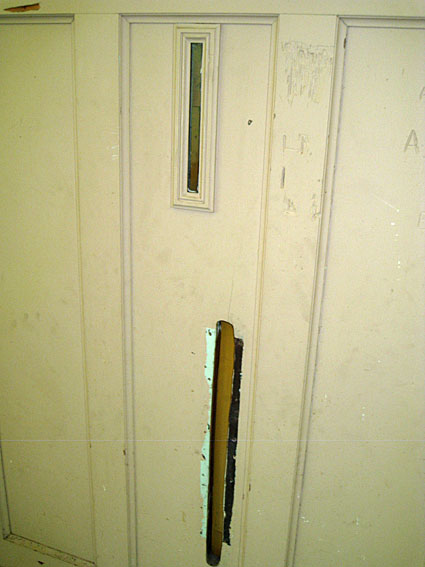
Evidence on the right-hand side of the casework of the original hand-blowing lever and
brass tell-tale wind indicator, enclosed behind a glass panel
[Photograph by Geoffrey Cox (September 2017)]
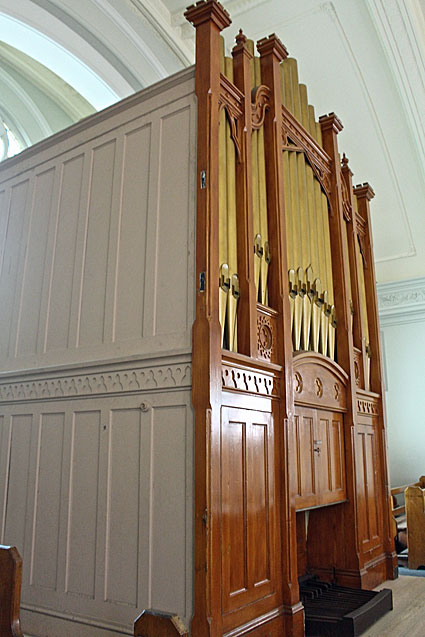
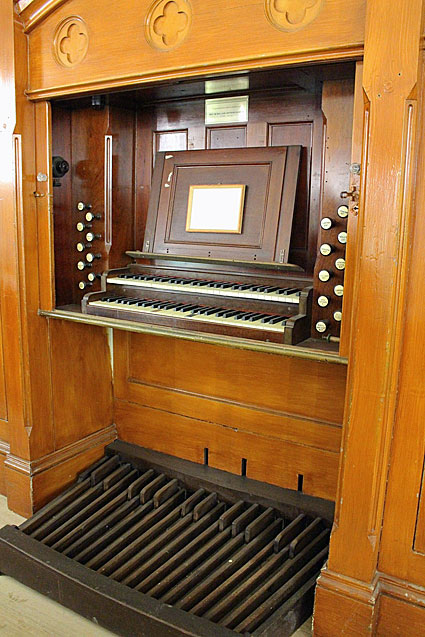
Console details of the 1884 Fuller organ
[Photographs by Trevor Bunning (2017)]
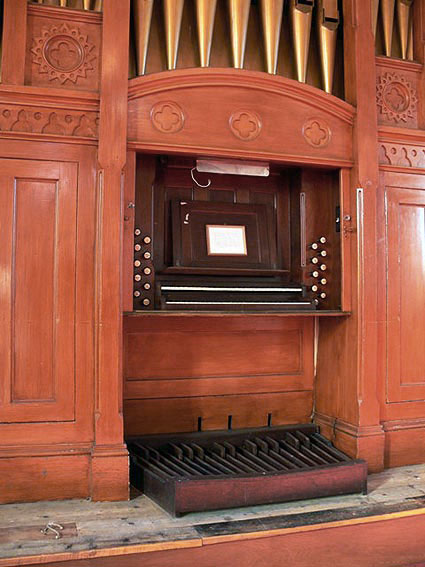
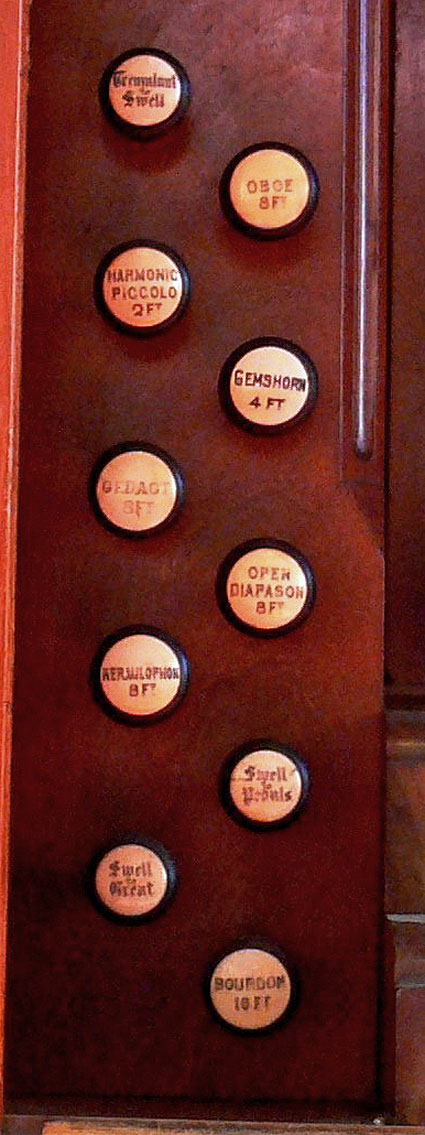

Console details of the 1884 Fuller organ
[Photographs by John Maidment (2006)]
The original pipe stencilling and casework decoration had been painted over prior to the rebuilding of the organ in 1968, but evidence of the original decoration can still be seen beneath the finish.
Fuller's slider windchests remain, as does the whole of the original pipework, apart from the Great Flautina and Pedal Violoncello. It is significant that the upper register (from middle C) of the Pedal Open Diapason 16ft, with which Fuller replaced the original Violoncello 8ft by the time the organ was installed at Brighton, now sits on a chest that was conceivably the original chest for the Violoncello 8ft, with stopped holes for the upper octave that was removed.15
Tonally, the instrument is still outstanding, and it has been classified by the National Trust of Australia (Victoria).
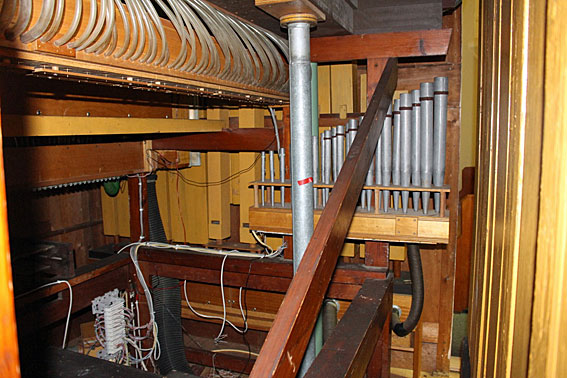
Interior of the organ
[Photograph by Trevor Bunning (September 2017)]

The upper windchest for Pedal Open Diapason 16ft,
showing stopped holes formerly used for the Violoncello 8ft
[Photograph by Geoffrey Cox (September 2017)]
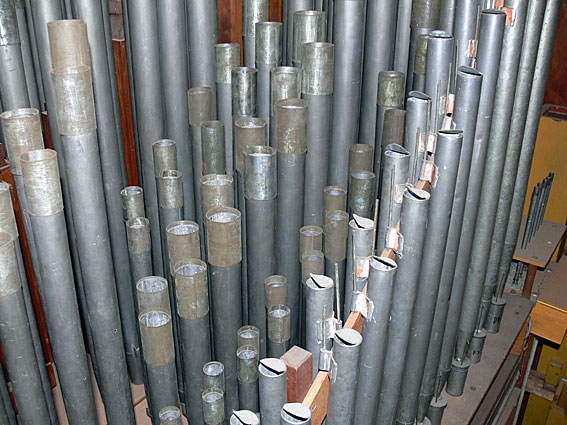
The Great Pipework of the 1884 Fuller organ
with the Cremona to the right
[Photograph by John Maidment (October 2015)]

The Swell Oboe pipes, viewed through the tuning flap
[Photograph by John Maidment (October 2015]
In the 1950s or 1960s, the Wesleyan Church at Brighton became 'Girrawheen Community Church', part of Girrawheen Nursing Home, a Uniting Church aged-care facility. The property was sold to Brighton Grammar School in 2004. The organ was partially refurbished in 2005, and maintained until February 2008.16
The instrument was given to St Brendan's, Flemington in November 2015.17 Following structural alterations to the gallery, minor cleaning and refurbishment, and installation of a new main cable to the console, it was installed at St Brendan's in August-October 2016 by Hargraves Pipe Organs of Mt Evelyn, Vic. The organ remains essentially as it was rebuilt in 1968 at Brighton, now enjoying a reverberant acoustic. The detached console is placed at floor level adjacent to the sanctuary, with the organ itself speaking freely from the gallery, unencumbered by the chamber it had occupied in Brighton.
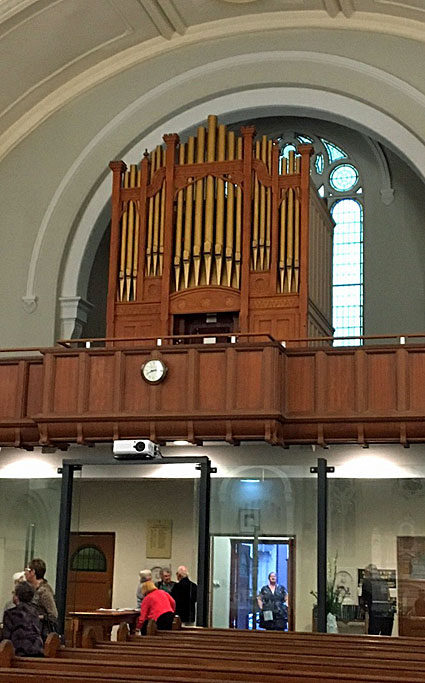
The Fuller organ in the gallery at St Brendan's
[Photograph by John Maidment (November 2016)]
Dedicated to the memory former of Parish Priest, Fr William Jordan (1935-2013), a long-time supporter and advocate of liturgical music in the Archdiocese of Melbourne and beyond, the organ was opened and blessed on Saturday 19 November 2016 at 6pm, the Vigil Mass of Christ the King. A short recital followed, featuring organists Paul Taylor and Thomas Grubb, soprano Gloria Wong and Moonee Valley Brass directed by Greg Flood.

The Memorial Plaque honouring Fr William A. Jordan
[Photograph by John Maidment (November 2016)]
The specification is as follows:
| GREAT Open Diapason Claribel Dulciana Principal Harmonic Flute Twelfth Fifteenth Cremona |
8 8 8 4 4 2-2/3 2 8 |
[originally 'Clarabella' in 1884] [1968; replaced Flautina 2ft] [bottom octave, 1968?] |
||
| SWELL Open Diapason Gedeckt Keraulophon Gemshorn Harmonic Piccolo Oboe Tremulant |
8 8 8 4 2 8 |
[originally 'Geigen Principal' in 1884; open wood bass outside the swell box] [originally 'Gedact'; metal trebles] |
||
| PEDAL Open Diapason Bourdon Flute Octave Flute |
16 16 8 4 |
[1893?; replaced Violoncello 8ft] [1968] [1968] |
||
| COUPLERS Great to Pedal Swell to Pedal Swell Octave to Pedal Swell to Great Swell Sub Octave to Great Swell Octave to Great Swell Sub Octave Swell Octave |
[1968] [1968] [1968] [1968] [1968] |
Detached stop-key console
Compass: 61/32
Electro-pneumatic action
3 thumb pistons to Great Organ
3 thumb pistons to Swell Organ
3 toe pistons to Pedal Organ
Great and Pedal Piston [Combinations combined]
Great to Pedal reversible toe piston
Balanced swell pedal.18
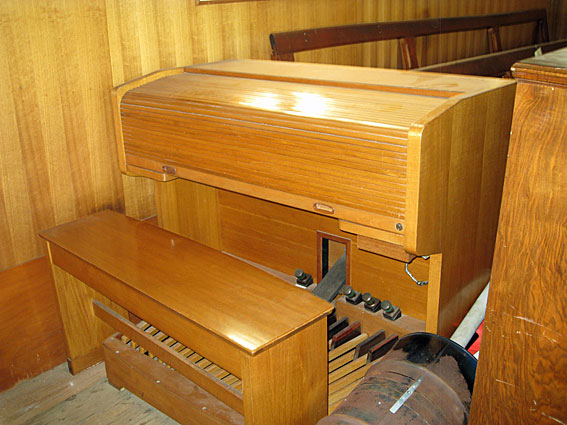
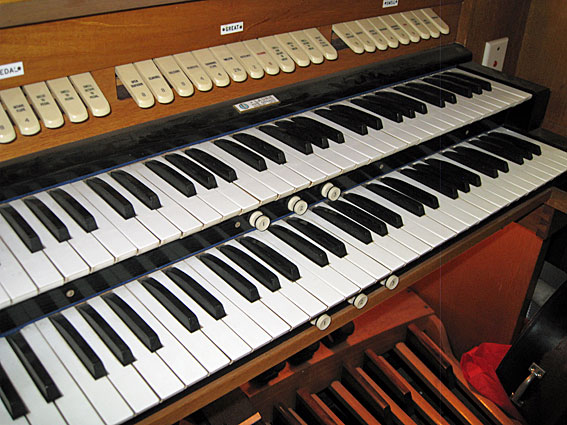
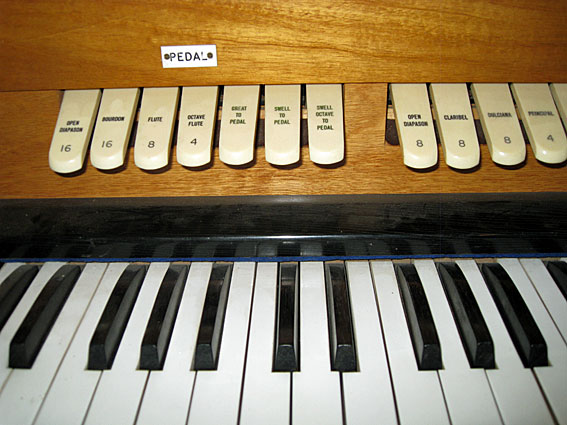
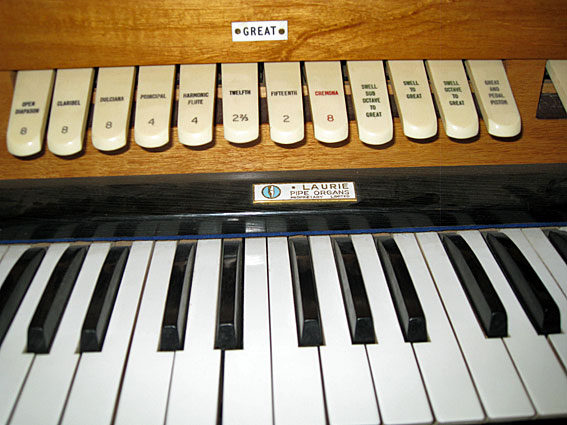
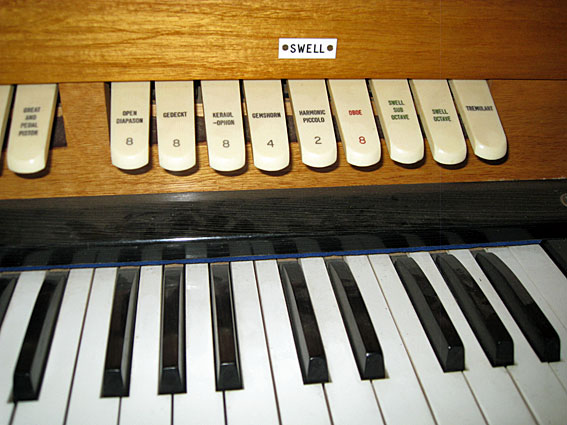
Details of the 1968 Laurie console
[Photographs by Geoffrey Cox (October 2015)]

St Brendan's Catholic Church, Flemington
[Photograph by Trevor Bunning (September 2017)]
1 The Advocate (26 June 1886), p. 14; Some of the Fruits of Fifty Years: Annals of the Catholic Church in Victoria (Melbourne: A.H. Massina, 1897), pp. 30-32.
2 The Advocate (20 March 1924), p. 7; (3 April 1924), p. 9; (10 April 1924), pp. 12, 13; (17 July 1924), p. 16; (24 July 1924), p. 21; (21 August 1924), p. 9; The Argus (4 July 1924), p. 15.
3 The Advocate (10 July 1924), p. 8; (24 July 1924), p. 21.
4 Victorian Heritage Database Report, 'St Brendan's Catholic Church.' http://vhd.heritagecouncil.vic.gov.au/places/23932/ - cited 16 October 2015.
5 Graeme Rushworth, 'Alfred Fuller, Melbourne 19th-Century Organ Builder – His Life and Work,' OHTA News, vol. 6, no. 4 (October 1982), pp. 3-19. Reproduced at http://www.ohta.org.au/doc/document.htm
6 The Victorian Independent and Journal of the Congregational Church, vol. 15, no. 171 (June 1884), p. 88.
7 The Argus (3 May 1884), p. 9; see also: The Age (Monday 5 May 1884), p. 5.
8 The Argus (14 August 1885), p. 5.
9 The Bendigo Advertiser (12 October 1876), p. 3; (19 September 1877), p. 3; (8 November 1882), p. 3.
10 The Age (18 February 1891), p. 1. This instrument now exists in altered form at Mark's Lutheran Church, Mount Barker, SA.
11 The Victorian Independent and Journal of the Congregational Church, vol. 22, no. 252 (March 1891), p. 51.
12 State Library of Victoria, George Fincham Letter Book 14, p. 189 (11 October 89), and p. 371 (13 December 1892).
13 The Oakleigh Leader (North Brighton, 18 March 1893), p. 4.
14 Bob Jefferson, Steve Laurie, Organ Builder: His Life and Works (Somers, Vic: [author], 1998), p. 248.
15 Personal communication from Campbell Hargraves to Geoffrey Cox, September 2016.
16 Dates 2004-08 supplied by John Phillips, Director of Advancement, Brighton Grammar School.
17 Geoffrey Cox, "Alfred Fuller goes to Flemington," OHTA News, vol. 40, no. 4 (October 2016), pp. 27-30.
18 Current specification noted on the Laurie console at Brighton, October 2015, and at Flemington, September 2016.